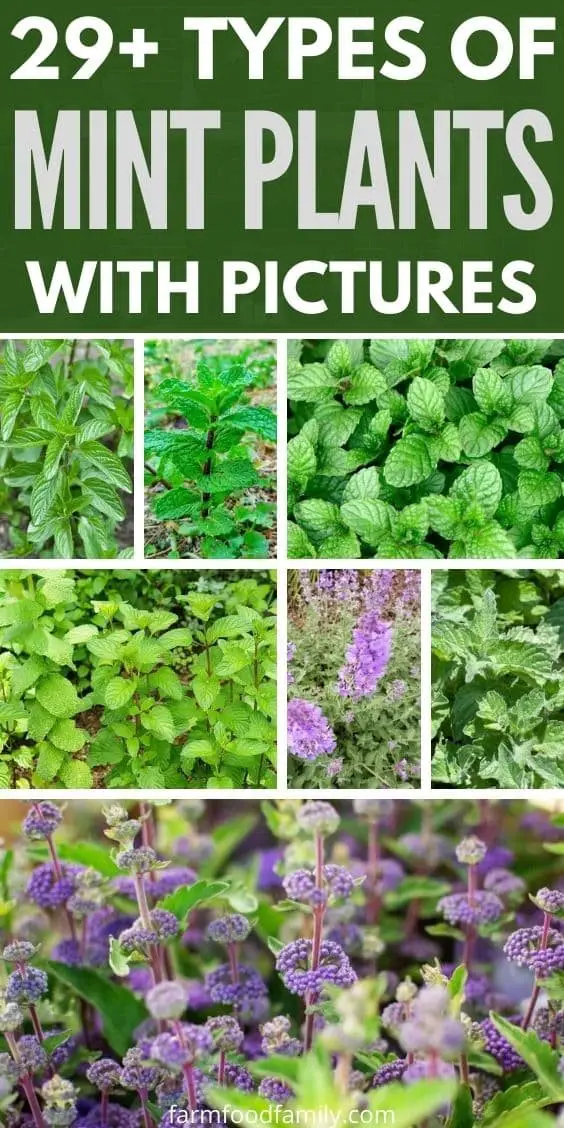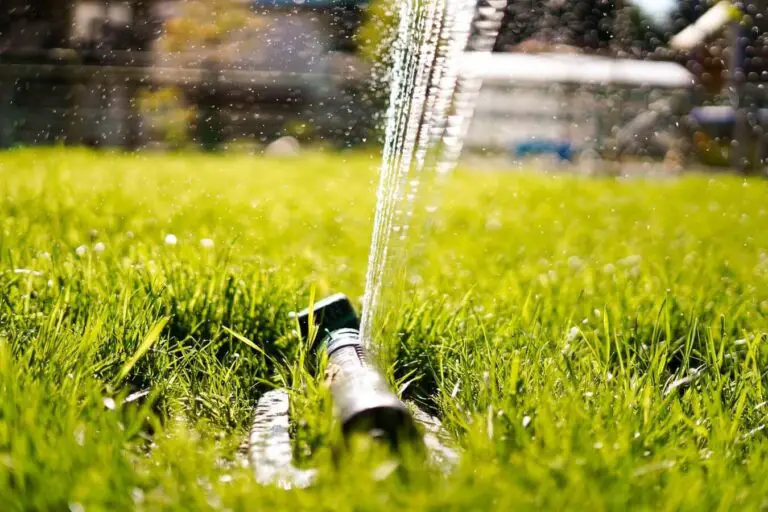Calathea: Varieties, Growing And Care For Rattlesnake Plant, Zebra Plant
Calathea plants have taken the world of indoor gardening by storm, and it’s easy to see why. These stunning houseplants are not only low-maintenance but also bring a touch of tropical elegance to any room. While they’re originally meant for outdoor growth, many people enjoy cultivating them indoors, finding it a fun and rewarding experience. In this comprehensive guide, we’ll delve into the most popular Calathea types, as well as provide valuable insights on how to care for these lovely plants.
From watering and propagation techniques to pruning and fertilizing tips, you’ll be well-equipped to nurture your Calathea into a thriving, beautiful specimen. So, let’s dive in and explore the wonderful world of Calatheas!
Facts About Calathea
Before diving into specific Calathea types, it’s essential to understand their fundamental needs. As tropical plants, Calatheas thrive in bright locations with filtered sunlight. While direct light can be beneficial, intense rays should be avoided. Soil moisture is also crucial – aim for a consistent level of moderate wetness, neither too soggy nor parched. Temperature-wise, these plants are sensitive to cold and do best in room temperature, ranging from 18-24 degrees Celsius.
Calatheas are naturally adapted to humid environments, making them ideal for capturing excess moisture in your living space or office. Finally, fertilization is not essential for these plants, which can grow well without it. However, during the growing season, you may notice an improvement with occasional feeding when flowers start to bloom.
Types of Calathea
While our previous discussion covered the fundamentals of Calathea plants, it’s essential to highlight some of the most popular varieties that thrive in indoor environments. With over 20 distinct species, selecting the right Calathea for your home can be overwhelming. That’s why I’ll focus on the top 21 best Calathea plants for indoor care, providing you with a comprehensive guide to choosing the perfect one for your space.
Calathea Orbifolia
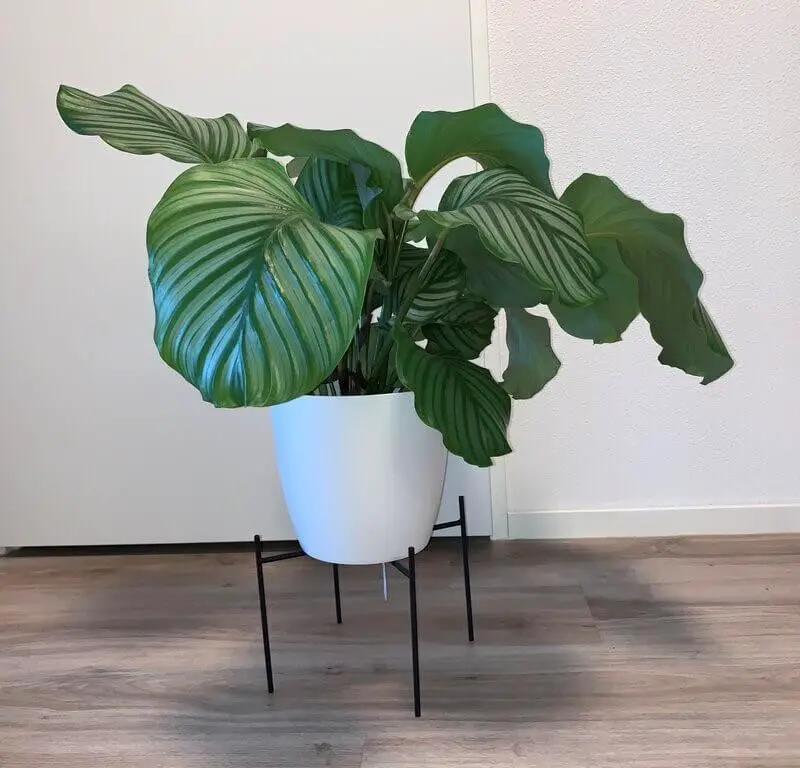
One of the most striking species of Calathea is the Calathea Orbifolia, which boasts some of the largest leaves among its peers. Its striking silver-striped foliage imparts an air of sophistication and visual appeal. Given its relatively low-maintenance requirements, it’s no surprise that this elegant plant has become a popular choice for offices and homes alike.
Calathea Ornata (Pin-Stripe Calathea)
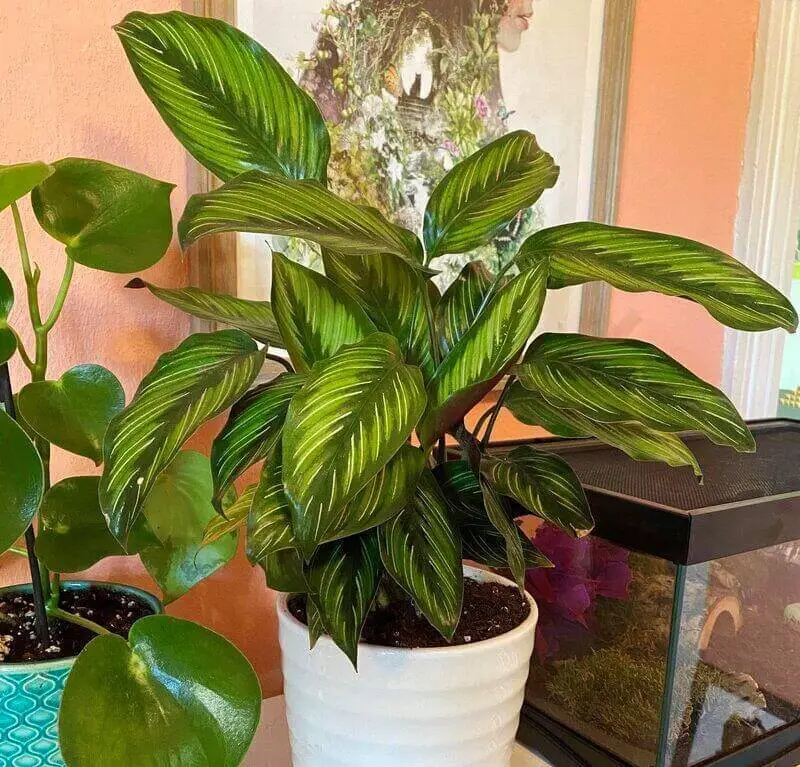
The pin-stripe Calathea, also known as Ornata, boasts a striking appearance with its large green leaves and vibrant pink stripes. While it may require some extra attention, this plant is surprisingly easy to care for in the home environment. Like many other Calathea species, Ornata thrives in high humidity conditions, making it a great candidate for indoor cultivation even if you tend to err on the side of overwatering.
Calathea Medallion
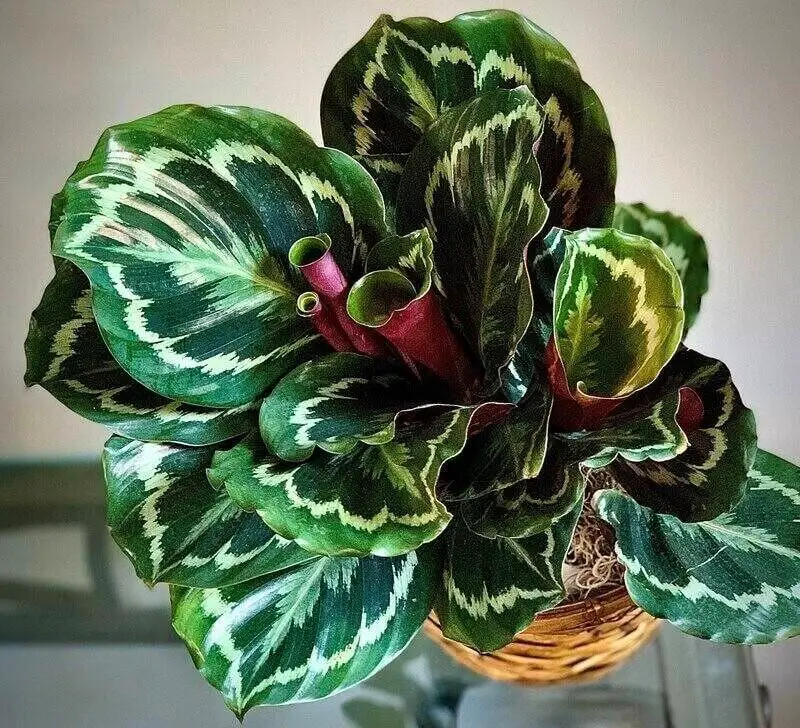
The Calathea Medallion is an eye-catching addition to any space, boasting two unique features that captivate many. Its striking name stems from the remarkable shape of its leaves, which are remarkably circular in appearance, with a light green border and center that evokes the image of an actual medallion.
Calathea Lancifolia (Rattlesnake Plant)
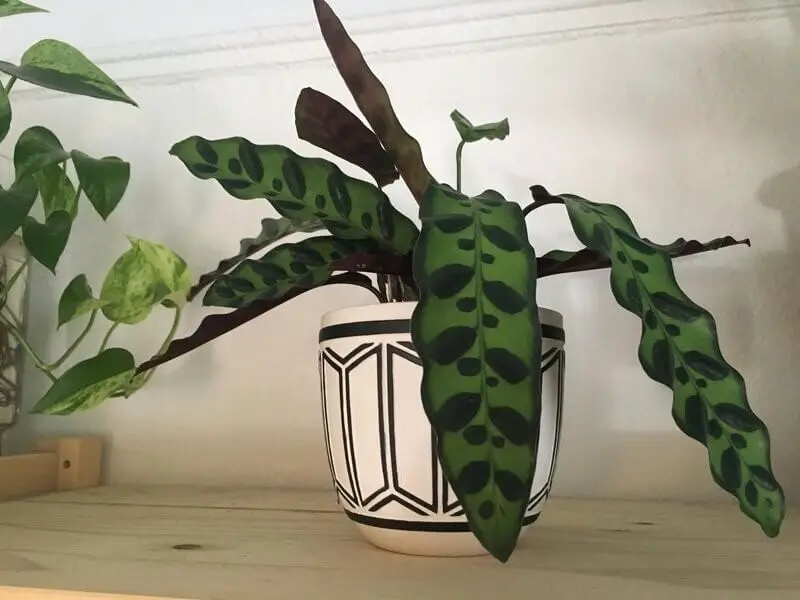
At first glance, Calathea Lancifolia may strike a resemblance to certain snake plant varieties due to their shared leaf characteristics. But for those familiar with the world of plants, it’s unlikely that this similarity will go unnoticed. Upon closer inspection, the true uniqueness of Lancifolia reveals itself: its long, curved leaves boast an intricate pattern reminiscent of the rattlesnake’s tail. This striking visual detail is, in fact, the origin of the plant’s name.
Calathea Musaica (Network Plant)
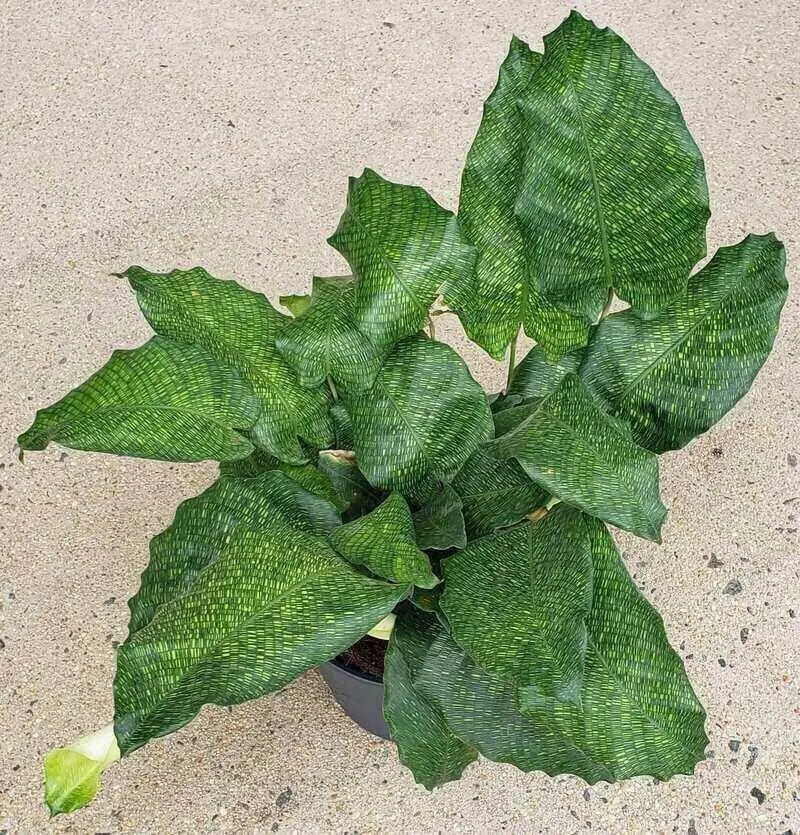
Calathea Musaica, or more commonly referred to as the Network Plant, originates from South America – specifically Brazil. Its most striking feature is the intricate leaf pattern, which resembles a mosaic artwork. This distinctive design earned the plant its namesake, with the ‘Network Plant’ moniker also aptly describing the pixel-like patterns that adorn its leaves.
Calathea ‘Misto’
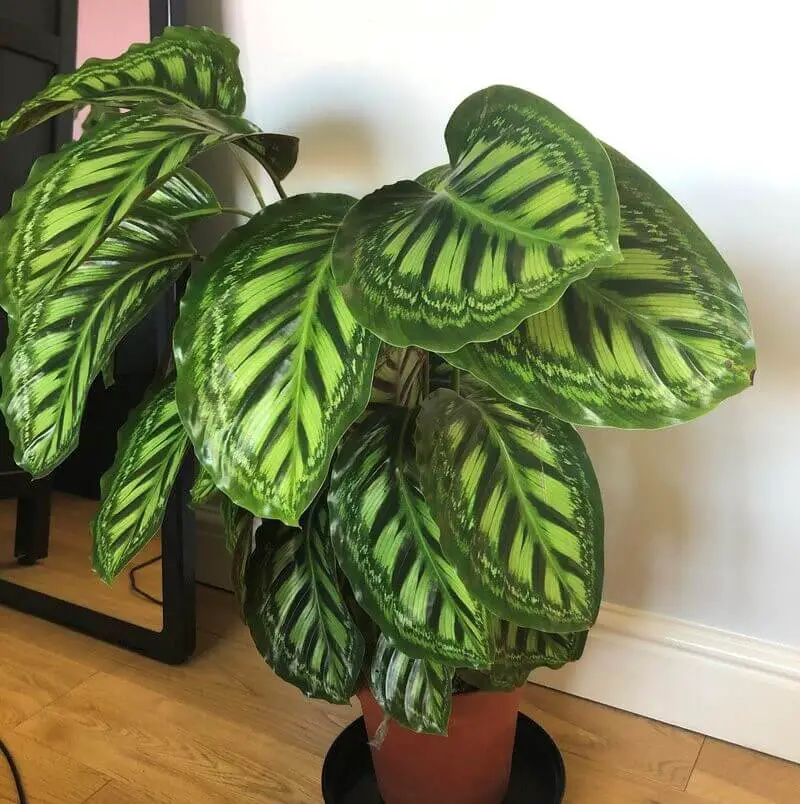
Characterized by its elegant foliage, Calathea ‘Misto’ boasts long green leaves featuring a striking light green stripe that spans across the central portion. This low-maintenance plant has gained popularity due to its ease of care, making it a common sight in both professional settings and residential spaces, such as offices and living rooms.
Calathea White Fusion
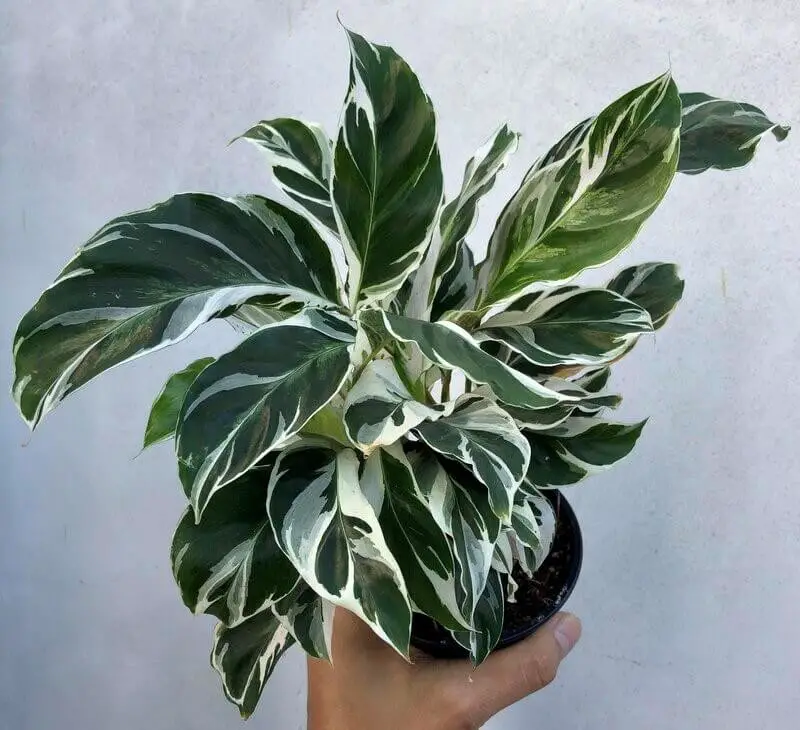
The Calathea White Fusion, also known as Calathea Leitzei, is a striking specimen that boasts a one-of-a-kind leaf pattern. This intriguing plant features an amalgamation of colors – think green, silver, and white – which gives it a truly unique visual identity.
Calathea Makoyana (Peacock Plant)

The Calathea Makoyana boasts stunning silver leaves adorned with a striking green feather pattern, earning it the nickname ‘Peacock Plant’. Not only does its magnificence elevate any space, but it also excels at air purification. Its unique foliage and impressive cleaning capabilities make it a prized addition to any home or office.
Calathea Roseopicta (Rose-Painted Calathea)
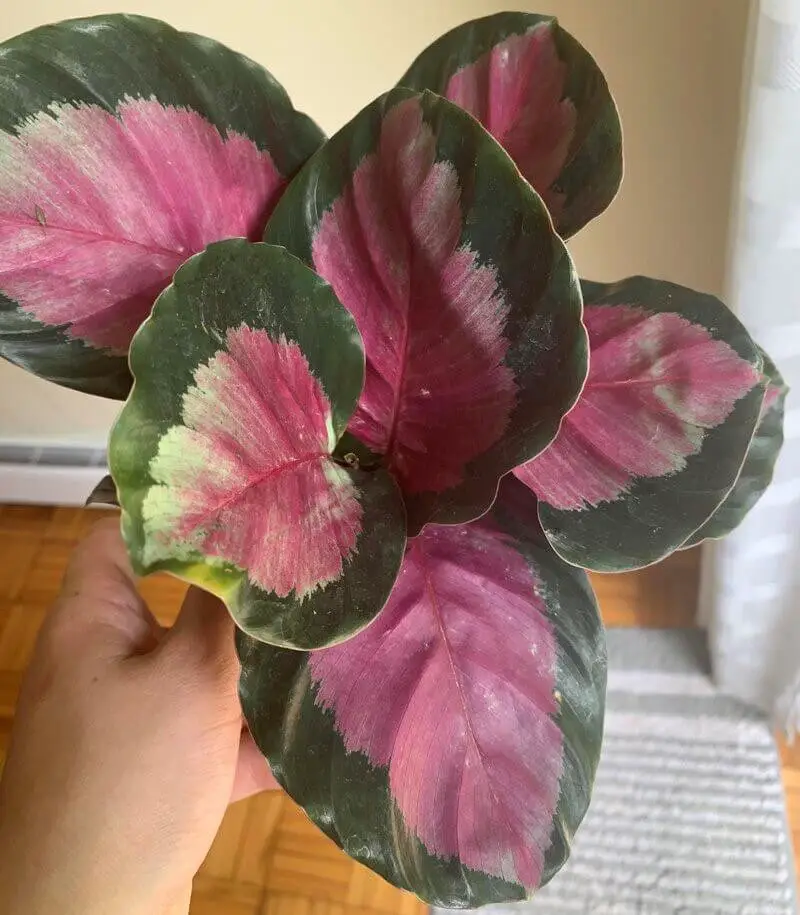
At first glance, Calathea Roseopicta appears to be a typical Calathea species. However, it’s only when you flip it over that you’ll notice something truly unique about this plant. While its top side boasts a harmonious blend of green, pale green, and white hues, the reverse side is where things get really exciting – it’s a vibrant pink! The sizeable leaves can grow quite large, making this an ideal choice for offices or spacious living rooms where its beauty can truly shine.
Calathea Freddie
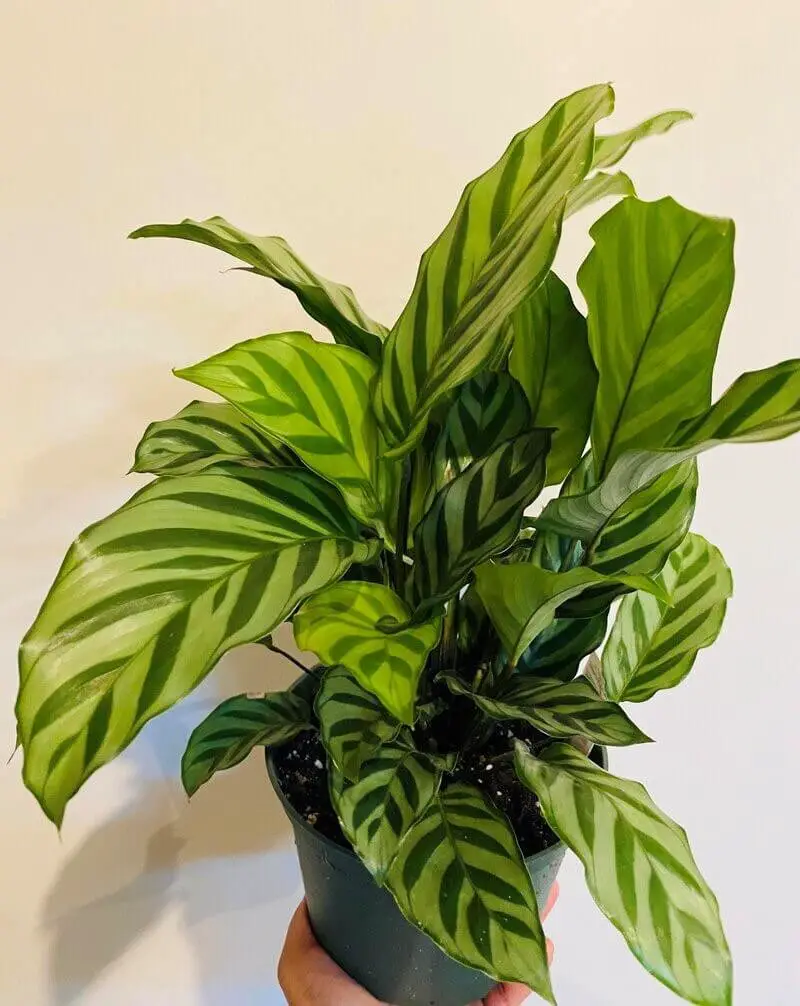
While not the largest variety of Calathea, Calathea Freddie is an adaptable and charming option that can thrive in a range of environments. Its striking silver leaves with intricate green stripes and curved veins are sure to add visual interest to any room. Despite its smaller stature, this cultivar still requires similar conditions to its larger counterparts – think consistent watering and the right balance of light and temperature.
Calathea Zebrina (Zebra Plant)
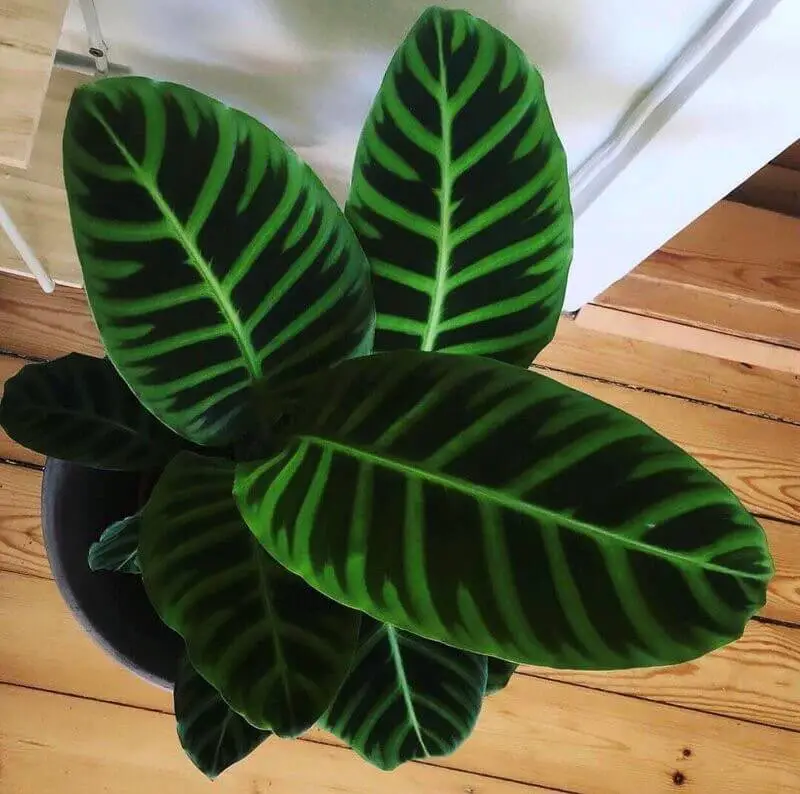
Calathea Zebrina, also affectionately known as the Zebra plant, is an iconic and eye-catching addition to any indoor space. Reaching heights of up to 1 meter, this stunning specimen boasts long, large leaves with a striking green hue and a unique zebra-like pattern that spans its entire surface. As it grows quite robustly, you can expect to need to repot your Zebra plant every couple of years or so, allowing it to thrive in its new surroundings.
Calathea Rufibarba (Furry Feather Calathea)
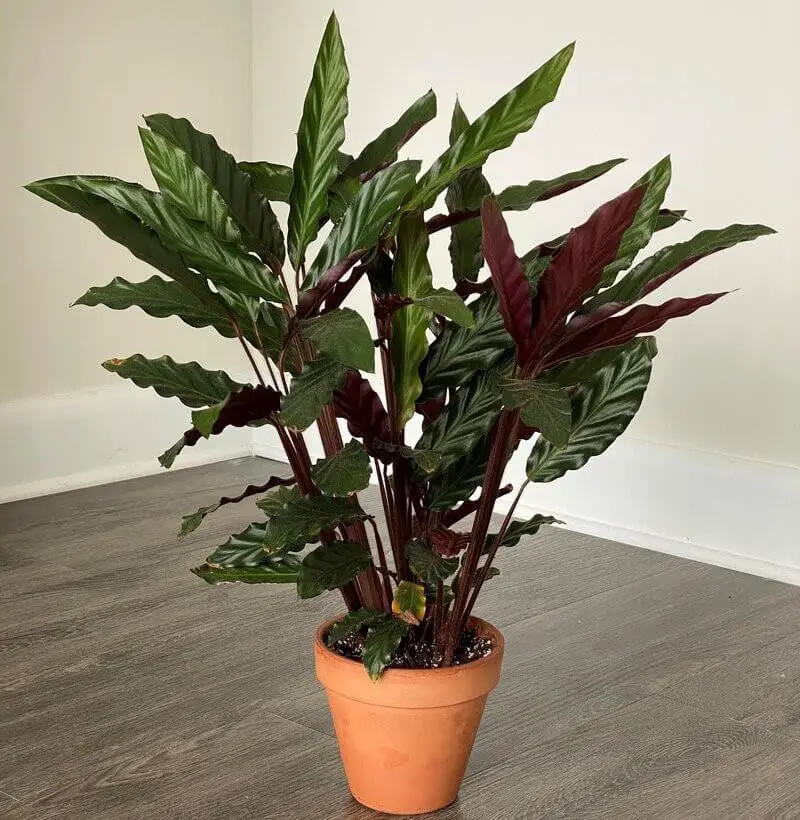
One of the most striking Calathea varieties is the Rufibarba, also referred to as Velvet Calathea or Furry Feather Calathea. Its distinctive feature is the short hairs that cover its leaves, imparting a velvety texture and waxy feel when touched. Characterized by long leaves boasting a striking combination of green and dark blue hues, with a deep purple underside, this plant exudes an air of sophistication.
Calathea Warscewiczii
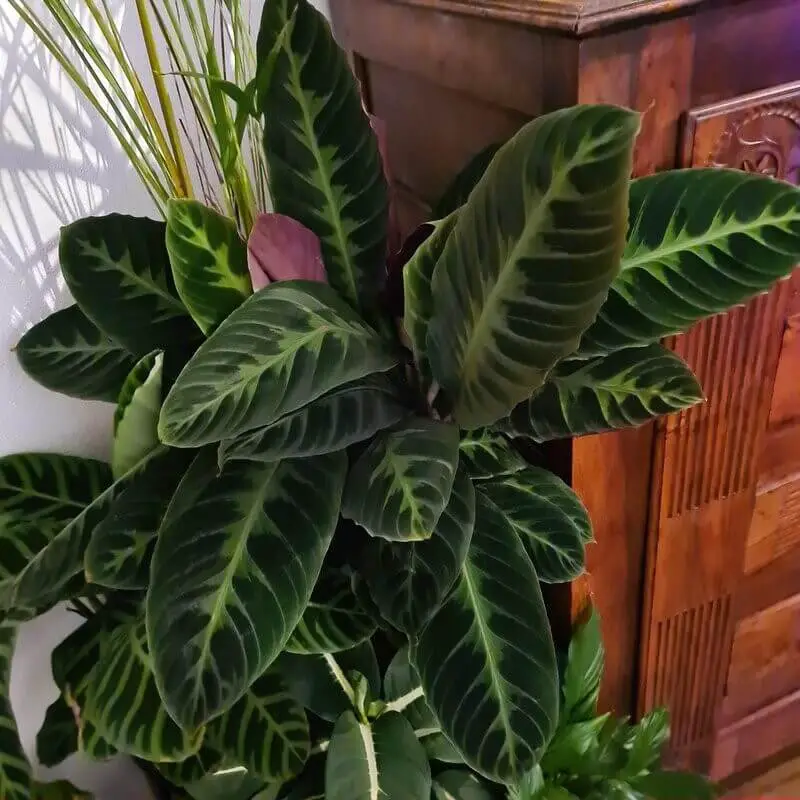
Calathea Warscewiczii, also affectionately known as Calathea Jungle Velvet, boasts one of the most challenging names to pronounce among the Calathea family. Despite its complex moniker, this plant is a gem that thrives in humid environments and can reach impressive heights of up to four feet when properly cared for.
Native to Central and South America, Warscewiczii’s tropical roots mean it has a natural affinity for warm temperatures and high humidity levels.
As such, it excels in room temperature settings and requires little maintenance to flourish.
Calathea Triostar
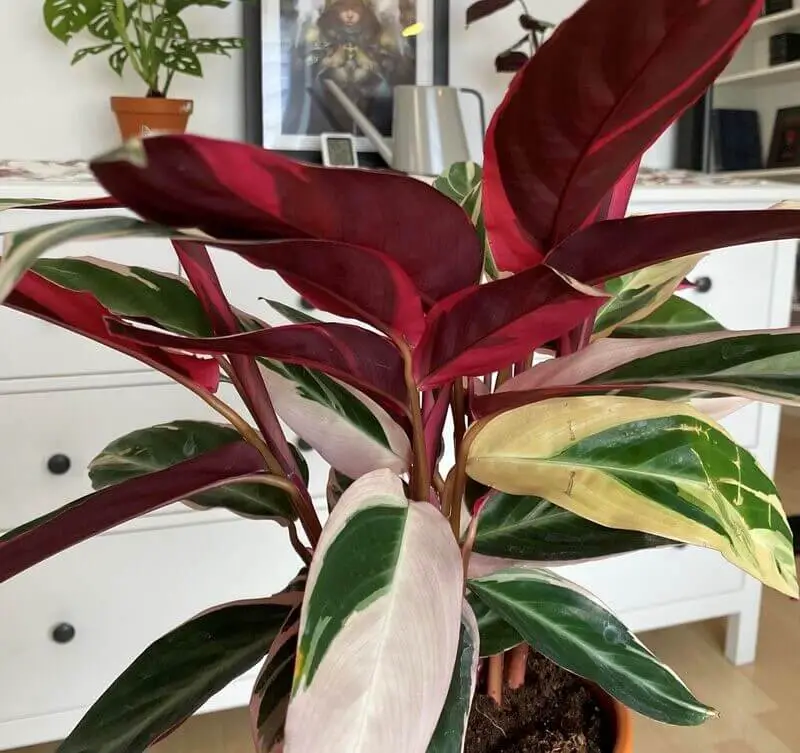
By combining various Calathea species discussed earlier, you can approximate the appearance of Calathea Triostar. This striking plant is characterized by its leaves featuring a harmonious blend of green, pink, and white hues, giving it an unmistakable visual identity. Interestingly, like many other Calatheas, this species hails from the lush Amazon rainforests, implying that it thrives in humid environments, much like its relatives.
Calathea Concinna
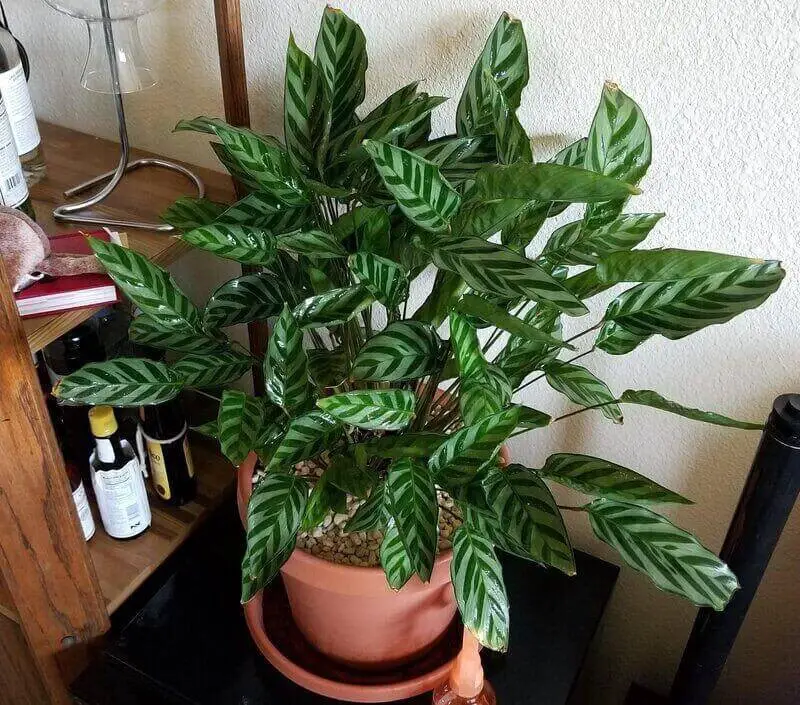
Calathea Concinna shares an uncanny resemblance to Zebrina and Freddie, often leading to mistaken identities between the three. A closer inspection of its leaves reveals a thicker zebra pattern, mirroring that of its cousins. When it comes to environmental conditions, Concinna can thrive in a room setting where temperatures range from 19-27 degrees Celsius, making it an attractive option for indoor enthusiasts.
Calathea Crocata (Eternal Flame)
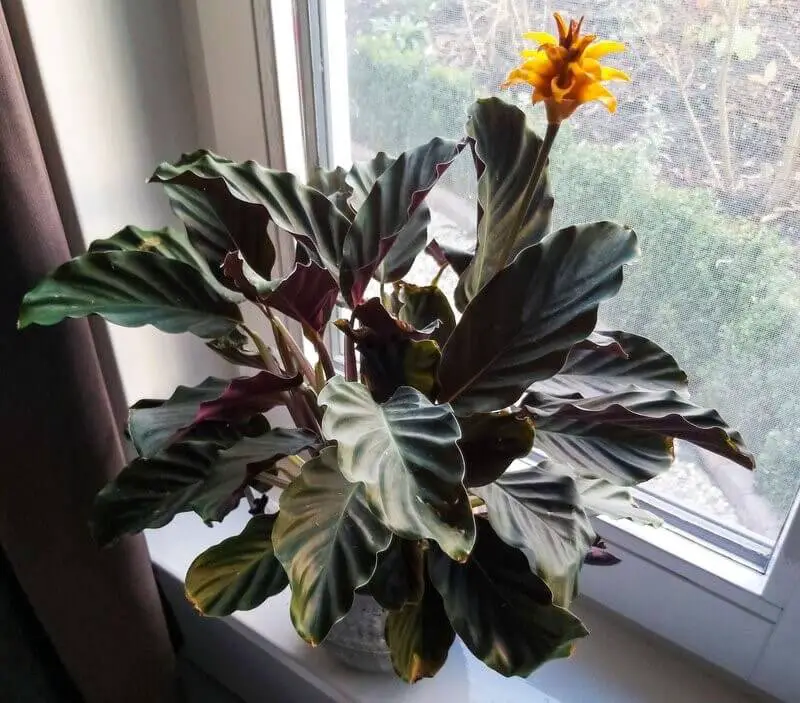
The Calathea Crocata is distinguished by its stunning yellow flowers with an orange fragrance that resembles a torch flame. These blooms typically persist for two months, providing a vibrant display. Beyond its striking flowers, this species boasts leaves with a unique metallic sheen, featuring a harmonious blend of green from the top, purple at the bottom, and subtle brown undertones.
Calathea Veitchiana
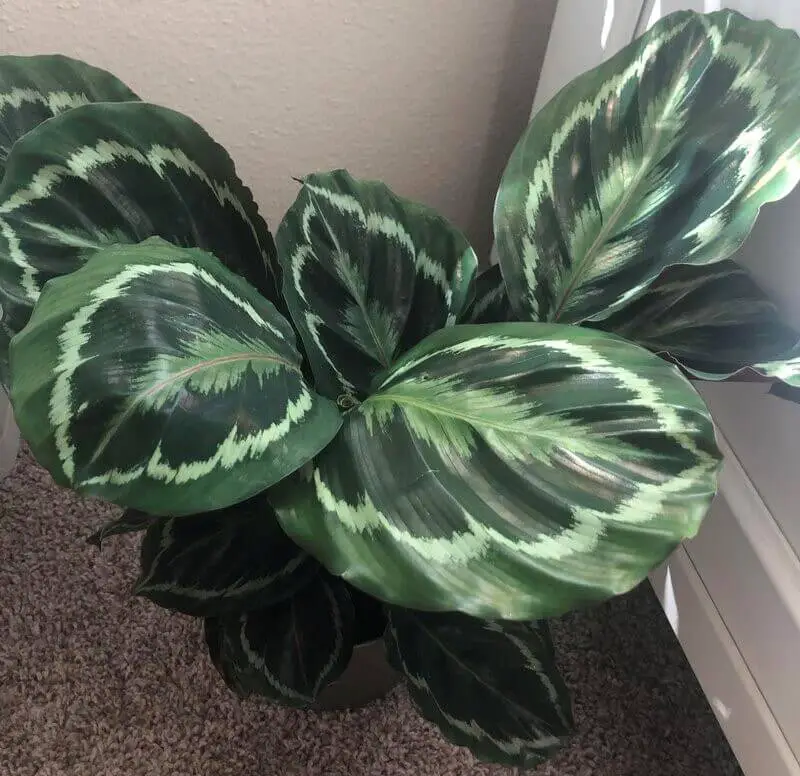
While Calathea Veitchiana is one of the larger species in the Calathea family, its large and rounded leaves can be a double-edged sword – they’re beautiful to behold, but also more prone to damage due to their size. As a result, careful handling is necessary to avoid harming these impressive foliage pieces. When it comes to soil and light conditions, Veitchiana follows the typical Calathea pattern, requiring well-draining soil and moderate indirect light to thrive.
Calathea Louisae
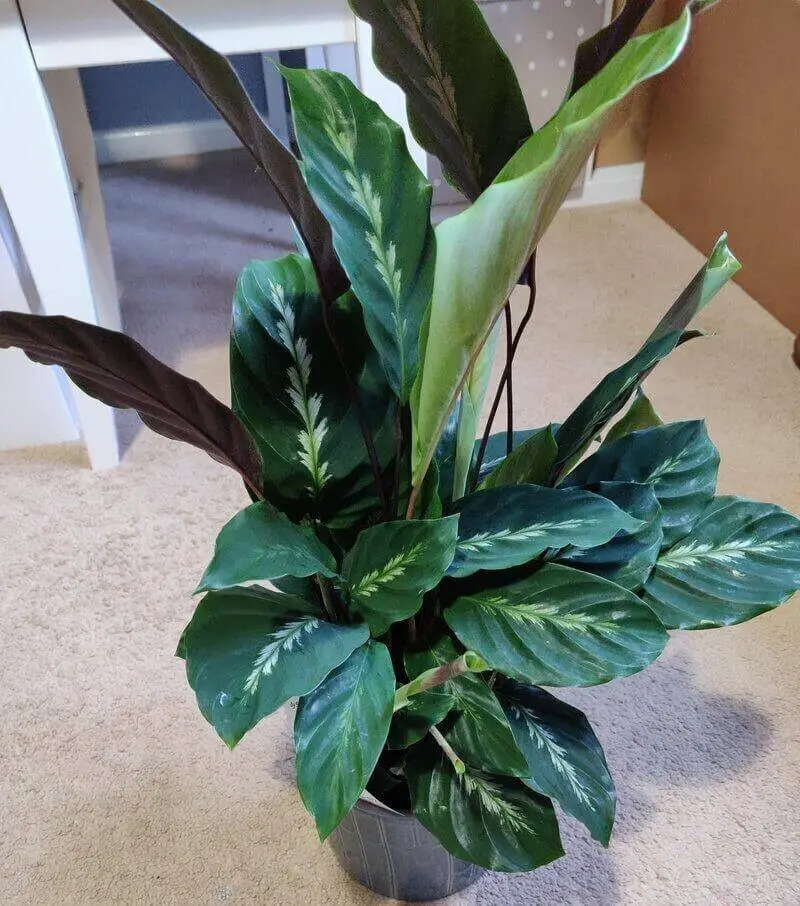
From the lush rainforests of Brazil, Calathea Louisae is a stunning plant that has also found its way to other parts of the world. Standing tall at up to 80 centimeters in height, this beauty boasts leaves that are a striking combination of pale and dark green hues. Measuring approximately 20 centimeters in length and 10 centimeters in width, these elegant leaves add an extra layer of visual appeal to this already captivating plant.
Calathea Dottie

Among the numerous varieties of Calathea Roseopicta is Calathea Dottie, a stunning plant that boasts an undeniable charm. Its striking features include dark purple leaves adorned with intricate pink ring-like patterns and stripes, creating a visually captivating display. Notably, this variety exhibits rapid growth, reaching up to 60 cm in height as it matures.
Calathea Vittata
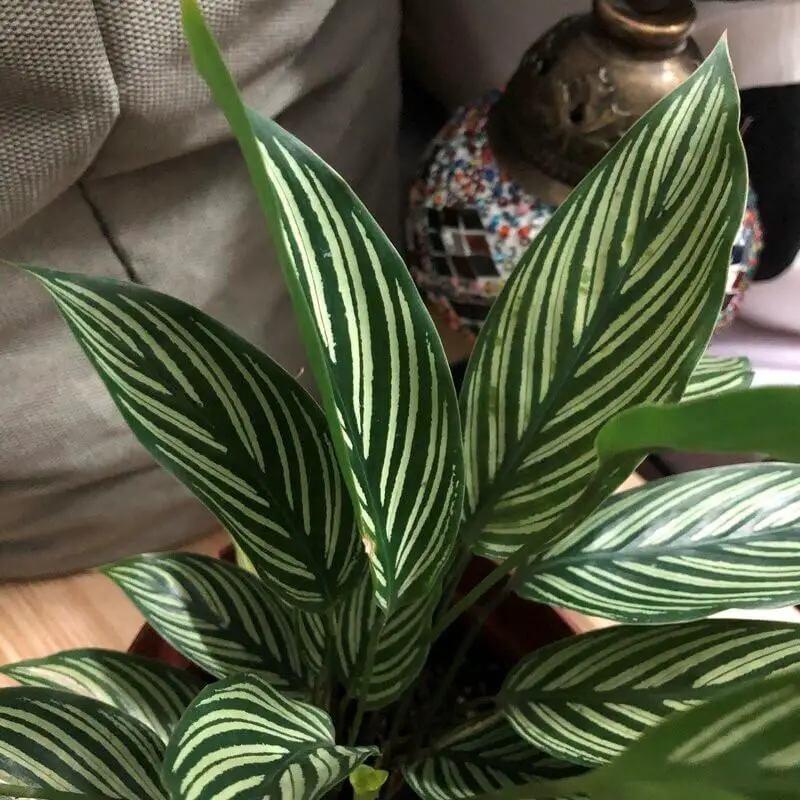
One of the most popular cultivated Calathea species is the Calathea Vittata, which originates from Colombia. Standing at a relatively modest height of 60 cm, this variety is one of the smaller Calatheas, but its unique appearance makes up for its compact size. The plant’s green leaves feature an interesting eclipse shape, punctuated by striking white stripes that add to its visual appeal.
Calathea Lutea
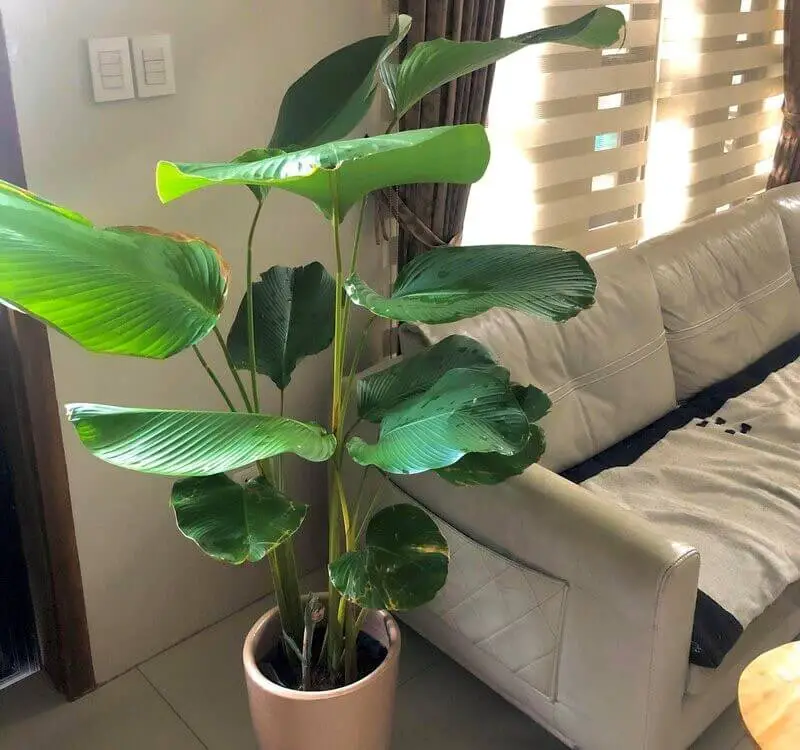
The majestic Calathea Lutea, commonly referred to as Cigar Calathea, Havana Cigar, or Cuban Cigar, stands out among other Calatheas for its remarkable size. This impressive plant can effortlessly reach heights of 2-3 meters, boasting massive leaves that resemble a paddle in shape. But what truly sets it apart is the striking feature of its long, brown flower, which bears a uncanny resemblance to a Cuban cigar – no surprise then, given the plant’s name.
Calathea Care
With the fundamentals covered, let’s dive into the essential aspects of Calathea care. This comprehensive guide will equip you with the knowledge necessary to successfully cultivate your very own Calathea, and enjoy its beautiful foliage in the process.
Soil
While there isn’t a specific soil type designed solely for Calathea plants, other options like African violet soil and Miracle-Gro Potting Mix can be suitable alternatives.
If you prefer to create your own potting mix, here are some guidelines to achieve success: A well-rounded blend typically consists of 30% eco-friendly potting soil devoid of peat; 25% perlite or pumice for improved drainage and aeration; 25% coir chips to enhance the soil’s water-holding capacity; and finally, 15% Hydrodrain or 5% charcoal to maintain optimal humidity levels. Keep in mind that excessive charcoal addition can be detrimental to your plant’s health.
Fertilizer
While Calathea plants don’t demand excessive fertilization, proper application can still make a positive impact on the soil’s mineral content and overall condition. When you do choose to fertilize your plant, consider doing so during warmer months – typically spring and summer – as this allows the nutrients to be absorbed more effectively. Winter fertilization is not necessary, and in fact, it may even cause more harm than good.
In terms of frequency, a couple of weeks between applications is generally sufficient. However, if you notice your Calathea isn’t experiencing any growth issues, you can always scale back on the fertilization efforts. It’s also important to note that newly propagated Calathea should not be immediately fertilized. Instead, wait for new foliage to emerge – a process that typically takes a few weeks – and then consider applying fertilizer.
This approach allows the plant to establish itself before receiving any additional nutrients.
Sun & Light
When it comes to lighting conditions, it’s essential to remember that Calathea plants thrive in environments with limited direct sunlight. Their natural habitat is in South American jungles, where the sun’s rays are filtered through lush foliage. To replicate this setting, place your Calathea in a spot receiving soft, indirect light, such as a north-facing window or a room with minimal direct sunlight.
Avoid placing it near a sunny window without curtains, as intense sunlight can cause damage to the leaves. Instead, opt for a shaded corner where dappled light and gentle illumination will provide the perfect conditions for your Calathea to flourish.
Water
When it comes to watering your Calathea plants, it’s essential to strike the right balance. Since they thrive in humid environments, they may require more moisture than other plants. The key is to maintain moderately moist soil at all times. If you do accidentally overwater your Calathea, don’t panic just yet – a little extra water won’t necessarily harm the plant immediately. However, if this becomes a consistent practice, it could lead to root rot and other issues.
To determine when your Calathea needs watering, simply check the soil’s moisture levels. Wait until the top 1-2 centimeters of the soil have fully dried out before giving it a drink. The frequency of watering will depend on various factors such as season, climate, and environmental conditions – you may need to water every few days or weeks. When it comes to the type of water to use, clean filtered water is always the best option.
Tap water is also acceptable, but it’s recommended to let it sit for a day before using it to water your Calathea. This allows any lingering coldness and chemicals to dissipate, which can be detrimental to the plant. If you prefer not to wait, consider investing in a water filter or purchasing distilled water from a store.
Humidity & Temperature
When it comes to temperature, Calatheas thrive in moderate conditions that fall within a specific range. They don’t do well with extreme temperatures, whether it’s scorching hot or bitterly cold. Ideally, they prefer temperatures between 18-23 degrees Celsius, which is typically room temperature. However, it’s essential to keep in mind that they’re sensitive to cold weather and shouldn’t be exposed to temperatures below 15 degrees Celsius.
Similarly, they don’t appreciate high temperatures either, so avoid placing them near direct sunlight or temperatures above 30 degrees Celsius. In terms of humidity, Calatheas are particularly fond of humid environments, with an ideal range of 50-60% air humidity. This means it’s best to place them away from ventilation shafts and air conditioning units, which tend to dry out the air. Instead, they do well in rooms without AC, where they can absorb moisture and help purify the air.
Repotting
When it comes to Calathea plants, growth rates can vary significantly from one individual to another. Typically, these plants need to be re-potted every two years or so, as their roots tend to outgrow their current container over time. This is usually due to the soil becoming depleted of nutrients and the roots needing more room to expand. Another reason for repotting might be to swap out the existing soil with fresh, nutrient-rich media.
When preparing to re-pot your Calathea, it’s crucial to choose a new pot with an effective drainage system to prevent waterlogged soil and root rot. To make the process smoother, water your plant the day before repotting. This will help soften the soil, making it easier to remove from the old pot. Begin by carefully removing the soil from the old pot, taking care not to damage any roots or disturb the plant’s delicate rhizome system.
Once you’ve exposed the roots and examined the plant for any potential issues, you can transfer it to its new home. Start by adding a layer of fresh soil about one-third deep, then gently add more soil and tuck the plant in place to stabilize it. After repotting, your Calathea may take a few weeks to adjust and resume normal growth. With proper care and attention, however, you can expect your plant to thrive in its new environment.
Pruning
While it’s true that some Calatheas can grow quite large, the majority of them will remain compact, typically staying below 2 feet in height. As a result, pruning is usually unnecessary. However, there are instances where pruning becomes necessary, and these mainly involve removing dead or diseased leaves to prevent the infection from spreading further.
Propagation
Calathea propagation can be achieved through two primary methods: separation and seeds. While seed propagation is more challenging due to the scarcity of genuine Calathea seeds, separation is a relatively straightforward process. To propagate by separation, start by clearing any excess soil from the roots and locate the natural points of root separation. Gently use your hands to split the plant into two or more specimens, taking care not to damage the roots.
Place each new section in its own pot and resume regular care, expecting new growths to emerge within a couple of weeks. Seed propagation, on the other hand, requires finding a trusted supplier for genuine seeds. Once acquired, sow the seeds at a depth of about 1 cm in a starting mix contained within a tray or pot. Water the soil using a spray bottle with a fine nozzle and place the pot in an area receiving indirect light.
As new seedlings reach approximately 3 cm in height, transfer them to individual pots and continue with regular care.
Pests
When it comes to Calatheas, you’ll experience minimal pest-related concerns. The only common pests that may affect these plants are mites, scales, mealybugs, and aphids. Fortunately, these unwanted visitors can be easily managed using simple techniques like water treatment or conventional pesticides if needed.
Diseases
Calathea plants are generally resilient to diseases, but they can still be susceptible to a few infections. One common issue is fungal growth, which can occur when the soil becomes waterlogged. A fungicide treatment can usually resolve this issue. Additionally, Calathea plants may also contract cucumber mosaic virus, characterized by yellow spots and wrinkled leaves.
While this infection won’t kill the plant outright, it can be problematic if you’re trying to propagate new growths, as they will inherit the infection and potentially compromise their appearance. Perhaps most concerning is pseudomonas blight, a fatal disease that can cause unsightly leaf spots. If your Calathea is afflicted with pseudomonas blight, unfortunately, it’s often necessary to dispose of the plant to prevent the spread of the infection.
Conclusion
With this comprehensive guide on Calathea types and care, you should now possess a solid understanding of how to nurture your own Calathea plant. From the diverse range of species to the specific needs of each type, I’ve aimed to provide you with all the necessary information to keep your Calathea thriving. I’m confident that you’ll be well-equipped to provide the ideal environment for your new or existing Calathea plant.
Related Posts
To embark on a career as a plant breeder, follow these step-by-step guidelines. First, earn a bachelor’s degree in botany, horticulture, or a related field to gain a solid understanding of plant biology and genetics. Next, develop a strong foundation in mathematical statistics, research methods, and laboratory techniques. Then, gain practical experience through internships or volunteer work at botanical gardens, universities, or breeding companies.
Pursue advanced degrees, such as master’s or Ph. D. s, to specialize in specific areas like crop improvement, plant pathology, or biotechnology. Finally, stay up-to-date with the latest research and developments by attending conferences, workshops, and seminars.

